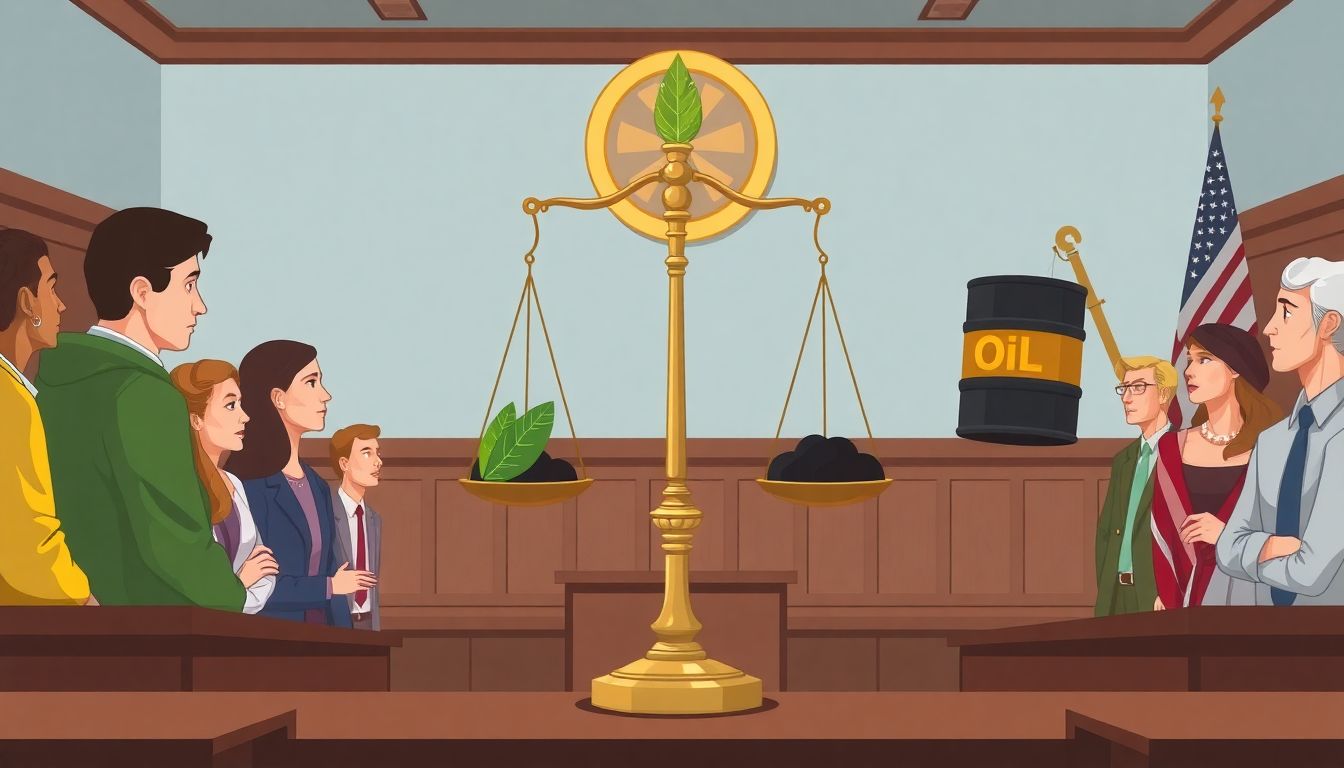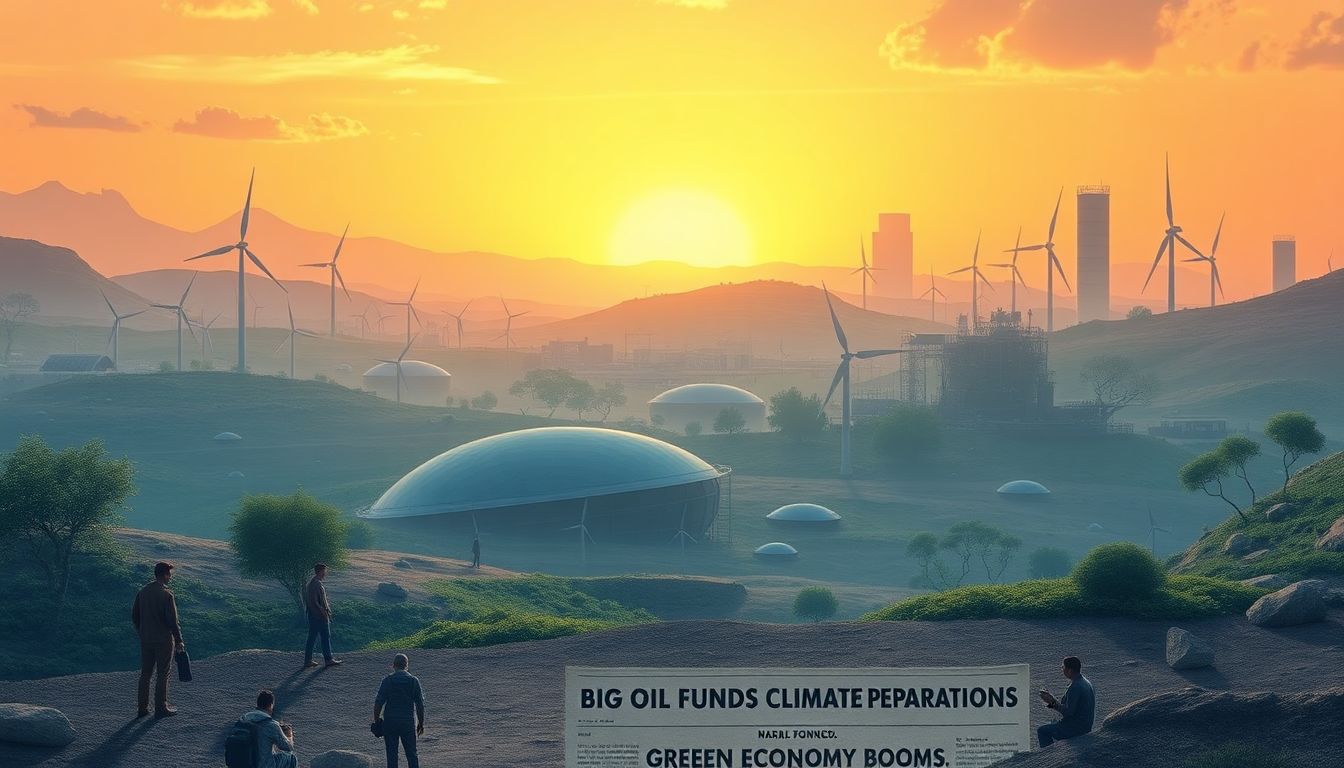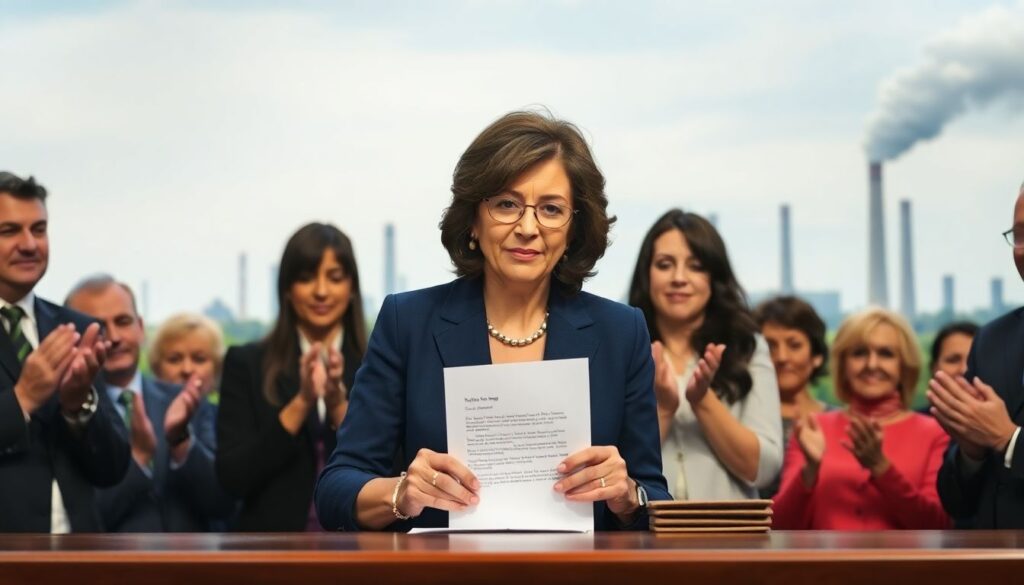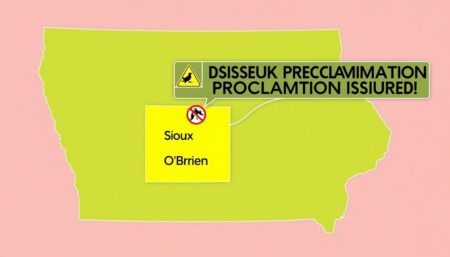Buckle up, dear readers! We’re diving into a groundbreaking environmental move by New York State that’s sending waves around the globe. Picture this: fossil fuel companies chipping in to clean up the mess that climate change leaves behind. That’s exactly what Governor Kathy Hochul has signed into law. Let’s explore this monumental step and what it means for the future of our planet.
A historic law shifts the burden of climate damage repair to major polluters. But will it stand the test of time and legal challenges?
In the vibrant heart of New York, Governor Kathy Hochul sits with a determined expression, her pen hovering over a document that embodies the state’s commitment to a greener future. The room is electric, filled with environmental advocates and lawmakers who have championed this cause, their applause echoing as Hochul signs her name with a flourish. This is not just ink on paper; it’s a promise, a testament to the power of collective will and a shared vision of a thriving, sustainable New York.
The backdrop of the scene is a stark contrast of memories and dreams. Faintly, the ghosts of industrial smokestacks linger, a reminder of an era when progress was measured in production and pollution was merely a byproduct. But these grey specters are eclipsed by a vivid image of a green landscape, a promise of what’s to come. Lush forests, clear skies, and sparkling waters illustrate the goal, the reason why the air in this room is thick with anticipation and hope.
The signing of this document is more than just a political milestone; it’s a testament to the evolving ethos of New York. It’s about job creation in renewable energy, cleaner air for our children, and acommitment to leaving our state in better shape than we found it. Today, under Hochul’s steadfast leadership, New York is not just signing a document; it’s signing onto a future that balances progress with preservation, innovation with sustainability.

The Dawn of a New Era in Climate Responsibility
In a landmark move for environmental policy in New York, Governor Kathy Hochul recently signed a new law that mirrors the federal Superfund law. This legislation, aimed at identifying and remediating hazardous waste sites, has been hailed as a game-changer for the state’s environmental landscape. Key players in this initiative include Governor Hochul herself, the New York State Department of Environmental Conservation (NYSDEC), and various environmental advocacy groups that have long championed stricter regulations on hazardous waste management.
The new law, much like the federal Superfund law, establishes a comprehensive framework for addressing contaminated sites. It includes provisions for:
- Identifying and prioritizing hazardous waste sites based on their risk to human health and the environment.
- Creating a dedicated fund to finance cleanup efforts, similar to the federal Superfund trust fund.
- Holding polluters accountable for the costs of remediation, a key aspect that aligns with the ‘polluter pays’ principle of the federal Superfund law.
The expected outcomes of this legislation are far-reaching. By addressing contaminated sites, the law aims to:
- Improve public health by reducing exposure to hazardous substances.
- Restore and protect the environment, particularly in communities disproportionately affected by pollution.
- Stimulate economic growth by redeveloping formerly contaminated sites into productive use.
What sets this law apart as a game-changer is its potential to transform New York’s approach to environmental justice. By prioritizing sites based on risk and environmental justice concerns, the law ensures that communities most impacted by pollution receive the attention and resources they need. Additionally, by holding polluters financially accountable, the law not only facilitates cleanup but also serves as a deterrent against future environmental negligence. This proactive stance on environmental policy positions New York as a leader in the national effort to address hazardous waste and promote sustainable development.

The Ripple Effect: New York Leads, Who Will Follow?
New York’s ambitious climate law, aiming for net-zero carbon emissions by 2050, is not just a statement of intent but a bold step that could have significant ramifications nationwide and globally. On a national scale, this law could stimulate other states to adopt similar legislation, creating a ripple effect that drives the United States towards its Paris Agreement goals, despite fluctuating federal commitment.
On a global scale, New York’s move sends a clear message to other countries that subnational actors, including states and cities, can lead climate action independently. This could inspire other regions worldwide to ramp up their climate ambitions, even if their national governments are slow to act. Moreover, by committing to such aggressive targets, New York is signaling to the international community that the U.S. is still invested in the global fight against climate change, regardless of federal inaction.
New York’s move sets a powerful precedent for other states and countries. By demonstrating that climate action is not only feasible but also economically beneficial, it provides a blueprint for others to follow. Here’s how this precedent could manifest:
- Other states could replicate New York’s approach, leading to a patchwork of progressive climate policies that drive national progress.
- Countries could look to New York as an example of how to set and achieve ambitious climate targets.
- The private sector could gain confidence in the renewable energy market, leading to increased investments and technological advancements.
Large Democratic states play a pivotal role in climate change mitigation, especially when federal leadership is lacking. Here’s why:
- Economic clout: States like New York and California have some of the world’s largest economies. Their commitment to climate action sends a strong signal to markets and investors.
- Policy innovation: These states often serve as policy laboratories, experimenting with novel approaches to climate mitigation that can later be adopted at the federal level.
- Global influence: Large states have international visibility and credibility, allowing them to drive global climate action even if the federal government is not actively engaged.
Their actions serve as a reminder that while federal leadership is important, it is not a prerequisite for significant climate progress.

The Legal Battle Ahead
The newly enacted law aimed at reducing greenhouse gas emissions is poised to face several potential legal challenges. Opponents, particularly the American Petroleum Institute (API), are likely to argue against the law on several grounds. Firstly, they may contend that the law is unconstitutionally vague, claiming that it does not provide clear guidelines for compliance. Additionally, API might argue that the law violates the Commerce Clause by imposing undue burdens on interstate commerce. Furthermore, opponents could assert that the law is preempted by federal legislation, such as the Clean Air Act, which already regulates greenhouse gas emissions.
The API might also raise concerns about the law’s potential to disrupt the energy market and impose significant economic burdens. They could argue that the law fails to consider the technical feasibility of reducing emissions to the prescribed levels, thereby imposing impractical standards on businesses. Moreover, API might contend that the law violates the takings clause of the Fifth Amendment, asserting that it amounts to an uncompensated taking of private property by diminishing the value of existing energy infrastructure.
In defense of the law, the state may invoke its police power to protect the public welfare, including the environment and public health. The state could argue that the law is a reasonable and necessary exercise of this power to address the pressing issue of climate change. To counter the vagueness argument, the state might point to the law’s specific emission reduction targets and timelines. Additionally, the state could present evidence demonstrating that the law does not discriminate against interstate commerce but rather applies equally to all businesses operating within its borders.
Assessing the law’s chances of holding up in court involves evaluating its constitutionality and the strength of the state’s justifications. Precedent suggests that courts often defer to states’ police power in matters of environmental regulation. However, the outcome will depend on the specifics of the law and the persuasiveness of the arguments presented. Factors influencing the decision may include:
- The clarity and specificity of the law’s provisions.
- The state’s ability to demonstrate a compelling interest in reducing greenhouse gas emissions.
- The balance struck between the law’s benefits and the burdens it imposes on businesses.
Ultimately, the court’s decision will hinge on whether the law is deemed a reasonable and constitutionally sound exercise of the state’s authority.

The Future of Climate Accountability
Imagine stepping into the year 2050, where the air is crisp and clean, and the hum of traffic is replaced by the gentle whir of electric vehicles and the laughter of children playing in safe, green spaces. This is the promise of the successful implementation of the Clean Air, Green Futures Law. Communities are no longer divided by sprawling highways but connected by expansive green belts, vibrant parks, and efficient public transit systems. Neighbors mingle in community gardens, tending to vegetables and fruits that thrive in the pollution-free air. The local economy is booming, but it’s no longer reliant on fossil fuels. Instead, it’s driven by innovative green technologies, creating jobs in renewable energy, sustainable agriculture, and eco-tourism.
The economy has evolved into a powerhouse of green innovation. New businesses have emerged, specializing in carbon capture, vertical farming, and advanced recycling technologies. Old industries have adapted, with former automotive plants now producing state-of-the-art electric vehicles and charging stations. The stock market is bullish on green tech, with investors pouring money into startups that prioritize sustainability. The success of the law has attracted international attention, positioning the country as a global leader in the fight against climate change. Trade delegations from around the world visit to learn from our success, sparking new collaborations and partnerships.
The environmental transformation is nothing short of astonishing. Forests, once decimated by acid rain and pollution, have regrown, providing habitats for wildlife that had long disappeared from the region. Rivers and lakes, once toxic from industrial runoff, are now clear and swimmable, teeming with fish and aquatic plants. The skies are blue, no longer marred by smog, and at night, the stars shine brightly, no longer obscured by a haze of pollution. The country has surpassed its carbon neutrality goals, becoming a net absorber of carbon dioxide. This has not only improved public health, with respiratory illnesses at an all-time low, but has also ignited a new sense of national pride and unity.
Inspired by this bold step, other initiatives have taken root and blossomed:
-
Green Roofs for Every Home:
A national campaign to install green roofs on residential buildings, providing insulation, absorbing rainwater, and promoting biodiversity.
-
The Zero-Waste Challenge:
A nationwide competition encouraging cities to achieve zero-waste status through innovative recycling and composting programs.
-
Eco-Education Act:
A comprehensive education reform that integrates environmental education into all subjects, from science and math to literature and arts.
-
The Green Job Corps:
A youth employment program focused on training and deploying young people in green jobs, from solar panel installation to urban farming.
The success of the Clean Air, Green Futures Law has proven that ambitious environmental legislation can transform not just the environment, but the economy and society as a whole. It has shown that a brighter, greener future is within our reach, and that with bold action, we can leave a lasting legacy for future generations.
FAQ
What is the expected financial impact of this law on fossil fuel companies?
How does this law compare to Vermont’s similar legislation?
What role does the federal Superfund law play in this new legislation?
What are the potential legal challenges facing this new law?
How might this law influence other states and countries?
- Other states may follow New York’s lead and introduce similar legislation, creating a ripple effect across the nation.
- The law sets a precedent for holding major polluters accountable, which could inspire other countries to adopt similar policies.
- By taking a stand on climate accountability, New York sends a strong message to the world that climate change mitigation is a priority.









